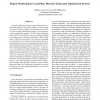Free Online Productivity Tools
i2Speak
i2Symbol
i2OCR
iTex2Img
iWeb2Print
iWeb2Shot
i2Type
iPdf2Split
iPdf2Merge
i2Bopomofo
i2Arabic
i2Style
i2Image
i2PDF
iLatex2Rtf
Sci2ools
CGO
2006
IEEE
2006
IEEE
Region Monitoring for Local Phase Detection in Dynamic Optimization Systems
Dynamic optimization relies on phase detection for two important functions (1) To detect change in code working set and (2) To detect change in performance characteristics that can affect optimization strategy. Current prototype runtime optimization systems [12][13] compare aggregate metrics like CPI over fixed time intervals to detect a change in working set and a change in performance. While simple and cost-effective, these metrics are sensitive to sampling rate and interval size. A phase detection scheme that computes performance metrics by aggregating the performance of individually optimized regions can be misled by some regions impacting aggregate metrics adversely. In this paper, we investigate the benefits and limitations of using aggregate metrics for phase detection, which we call Global Phase Detection (GPD). We present a new model to detect change in working set and propose that the scope of phase detection be limited to within the candidate regions for optimization. By ...
| Added | 10 Jun 2010 |
| Updated | 10 Jun 2010 |
| Type | Conference |
| Year | 2006 |
| Where | CGO |
| Authors | Abhinav Das, Jiwei Lu, Wei-Chung Hsu |
Comments (0)

